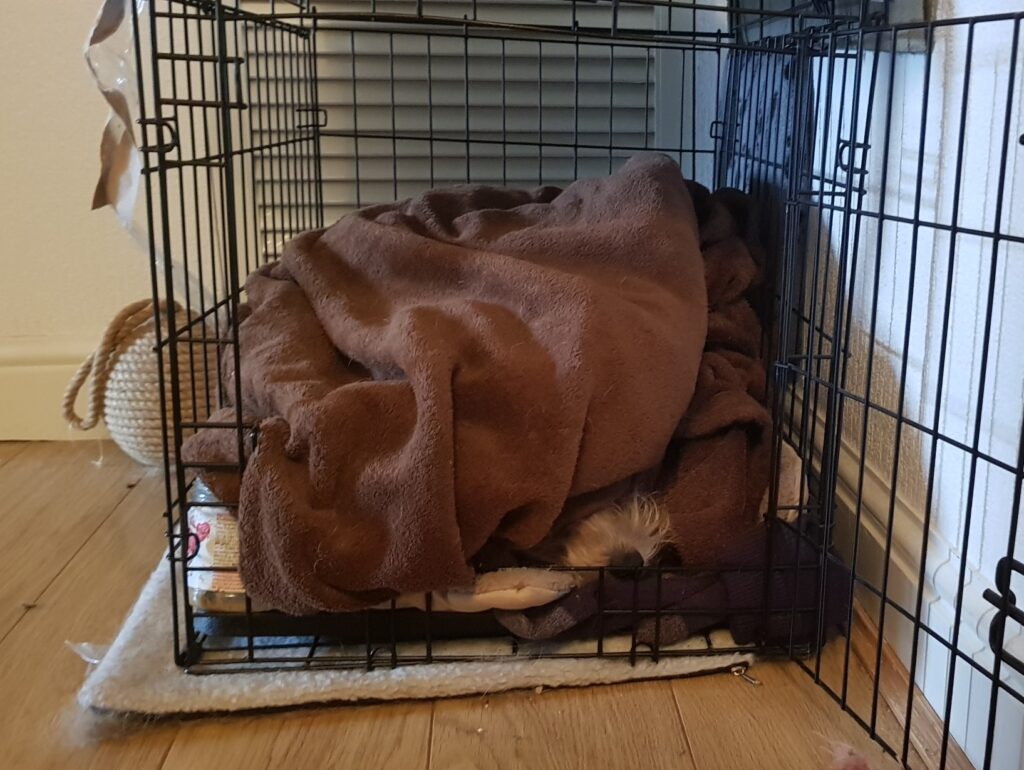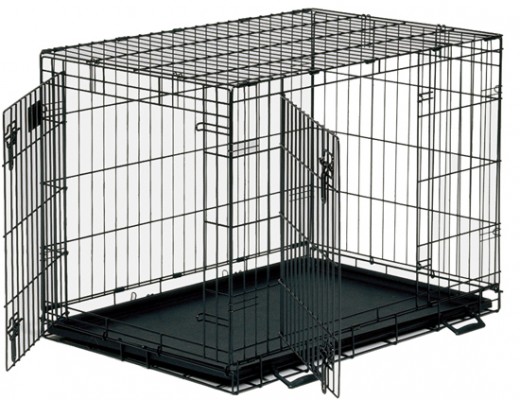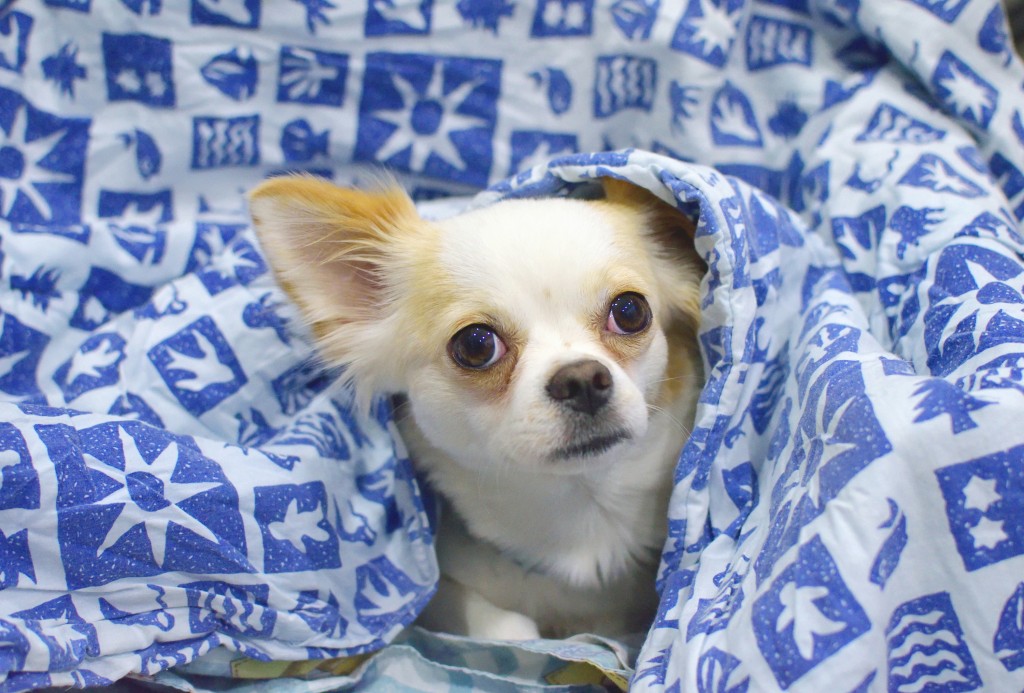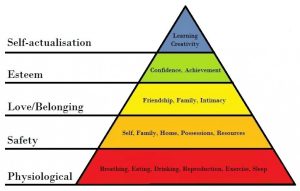Need help with Reactive Dog Behaviour? Join my FREE Facebook support group...
Pro’s and Con’s of dog training crates
Dog training crates are becoming increasingly popular. Used well, your dog will love their crate, but they aren’t for everyone. Here are some of the pro’s and con’s of crates and how to use them.
What is a training crate?
Basically, a dog training crate is a small enclosed box that is specifically designed for dogs to sleep in. They can be made of fabric, plastic, and wood. But, most are made of metal and are essentially just cages for dogs. It is because of this, that many people are put off by them. I can understand that point of view. I’m sure you didn’t get a dog just so you could lock him away in a cage; I know I didn’t.
However, we are looking at the crate from a human’s point of view. If we start looking at it from the dogs point of view, we now see a secure and cozy den that is only for them. When you look at it that way, it’s little wonder that dogs absolutely love them. And many prefer to sleep in them, just as my dog does. In fact, on the one occasion I forgot to take it away with us, she was particularly unsettled until I got her one!

Pro’s of using a crate
There are many good reasons to get a crate for your dog or puppy. The most obvious one being for the purposes of house training. House training can be a frustrating process at the best of times, so why not make it a little easier and use a crate? It works because dogs and puppies don’t like to pee or poop near where they sleep or eat. The crate reduces the amount of space the dog has to a comfortable sleeping area; this reduced space encourages woofers to hold on until he can get to a more appropriate place. Of course, this means that he will need to go as soon as you let him out. As long as you take him to a place you approve of, you should have an opportunity to praise him too. Basically, using the crate means fewer accidents and more opportunities for reward, which will vastly speed up the whole process for you both.
The crate is not just for toilet training, it also provides a safe place for your teething pup when you are unable to supervise him. This gives you peace of mind, and keeps him, and your furniture safe. Just remember to provide a chew toy that is safe to munch on while he is in his crate – just in case his teeth are sore.
| Toilet Training | Prevents Accidents | Security For Your Dog |
| Has a Calming Effect | Sanctuary From Others | Travel Safety |
| Offers Quiet Time | Pet Friendly Holidays |
A safe space
A pup that uses a crate will usually be much calmer and feel safer while he is in it. It is one of the reasons that many dogs return to their crates to sleep long after you have stopped closing the door. Due to the lack of room, the den-like space encourages nap time and prevents your pup from wandering and pacing. This leaves him no option but to settle himself, a valuable skill that many dogs could benefit from learning.
The crate can be used as a safe place too, especially if your excitable puppy needs the occasional quiet time. It is not to be used as a punishment though. Just a quiet place where your pup can settle himself down and chill for a bit.
A private sanctuary
If your family has young children, or you have a busy household, your pup may prefer the sanctuary that his crate offers. Just remember to teach the little ones that the crate is a special area meant only for the pup.
It also offers a safe way to travel in the car or caravan. Hopefully you are never involved in an accident, but if you are, you will be glad of the crate. Not only will it stop your dog being thrown about and causing injury to himself. It will also keep him from colliding with another passenger.
Lastly, some pet-friendly hotels and holiday apartments insist on crates being used in their rooms. They don’t want their room to be chewed up by a dog while you take a day out. I guess that’s fair, especially if it means more places allow dogs to stay in the future. The vet will use a crate too, so getting used to one is always a great idea – it’s one less thing for your dog to stress about if he ever has to get treatment.
I am sure there are many more good reasons to get a training crate for your dog, but I think I have covered the main ones here. If you can think of any, feel free to add them in the comments section below, I’d love to hear them.
Con’s of using a crate
I spent quite a bit of time searching for negatives to dog crates, and apart from a couple that only arise as a result of misuse, I could only really find two.
In most cases, as long as you use it properly, and introduce it gently, you will avoid many of the pitfalls that some people have experienced.
However, the first possible problem I considered is that the crate can encourage laziness. It should not be used as a substitute for training, but as a tool to assist training. Occasional quiet time is fine, but it is not ok to shut a dog in a crate for hours on end just because it is easier. If your dog needs more exercise or you don’t know how to train him then that can be fixed in better, more permanent ways.
Also, a dog may become stressed if the crate is overused. It should mostly be used when you are not around, and only for a maximum of four hours during the day, as well as overnight. If you are home, your dog should be with you where you can supervise and train him yourself.
| Encourages Lazy Training | Stressed if Overused |
| Used as a Punishment | Some Dogs Just Don’t Take To Them |
| Looks Ugly | Takes Up Space |
Keep it positive
The crate might be used as a punishment for a dog or puppy; this is not an appropriate way to train your puppy or use the crate. This will teach your dog to associate it with negative experiences and it will lose its usefulness. Any associations with the crate should always be positive.
It is also fair to say that, as with everything in life, there are some dogs that just don’t take to them. That’s a shame, but there are lots of different ways to train a dog, so don’t worry. Thankfully, the ones that don’t love them are pretty rare, it is such a natural environment for a dog.
Finally, two cons that have nothing to do with how you use the crate! First, they can be ugly and second, they do take up a lot of space. Both are important considerations. So think carefully about where it will go in your home before you spend your hard earned cash on one. I do think the benefits far outweigh the poor aesthetics though.

Choosing a crate
So, if you have decided to give it a go, the next step is to choose one that is going to suit you and your dog. The most common type is the wire crate (pictured above). These are secure and virtually escape proof. They don’t look great, but I advise everyone to throw a blanket over it anyway to make it snug and den like. So the look of it might not necessarily matter too much. You could also choose a fabric or wooden crate, both of these look nicer but are not as easily cleaned or secure as the wire version. Or you could go for a plastic one. These generally suit smaller dogs better. They are easy to clean, secure, and usually have a handle on the top so you can easily carry it around – assuming the dog inside is light enough, that is!
Whatever style you choose, you must choose one that is big enough for your dog or puppy to comfortably stand up, turn around, and stretch in, without touching the edges. Remember, if you are buying it for a pup he will grow quickly, so make sure you allow for that when you pick one out. Otherwise, you might have to replace it as he grows.
Introducing your dog to his crate
Now you have your training crate, let’s choose a place in the house that is comfortable for your dog. For example, not in a drafty place, or by a hot radiator. He’ll also prefer somewhere that is quiet and away from distracting doors and windows.
Once set up, I suggest you throw a blanket or large towel over the top of it so that all sides except the door are covered. Next, place a nice soft bed inside, and throw in some of his favorite treats and toys.
Now you are all set up, it’s time to let your dog in for the first time. As with all things that are new, they can seem scary at first. Just be patient with him, and he will go in in no time. Pups will take to a crate far more readily than an older dog, so you might be able to fast track these steps! Your pup might have already been in one with the breeder. If that’s the case, you’re good to go!
Don’t make a fuss of your dog if he goes in or not, it’s not important at this stage, he will go in when he is ready. When he does venture in, he will probably take out some of the goodies you have left for him. That’s ok, quietly add a new toy or some more treats.
Don’t be in a hurry to shut the door
Don’t be in a hurry to shut the door on the first day. Just let him come and go freely while he familiarizes himself with his lovely new bed.
On the second day, you could try closing the door while he is inside and then opening it almost straight away. Use lots of calm praise so he associates it with only good things. If he is happy for you to close the door, try closing it for increasing amounts of time while you sit beside him.
On the third day; assuming day two went well, it is time to close the door and leave your pup for the first time. It is better to be gone for only a very short time the first time you leave him, maybe ten minutes or so, to see how he gets on. From there, as long as he is coping well, you can increase the time to half an hour, then an hour and then up to four hours.
You might also consider using a DAP (Dog Appeasing Pheromone) spray. You can get this from your vet and it should help to reduce any anxiety. It is especially good for younger dogs, but can offer some relief to any age of dog. Or if you prefer, lavender oil is also helpful, just add a few drops to his bedding to help him relax.
Whatever happens, your success at introducing the crate lies mostly in your patience. Don’t rush your dog, let them accept it in their own time. All you need to do is to keep it positive and rewarding for him. He will love his new bedroom in no time.
What if my dog hates his crate
If you have taken your time introducing the crate properly, you shouldn’t expect too many problems. But every dog is different and they don’t always respond how we expect. So here are a few issues you might encounter, and how to overcome them.

The first problem might not have anything to do with the actual crate. If your dog is becoming stressed, it is possible that you have a dog that is suffering with separation anxiety. In extreme cases a dog can become anxious just because they are not in direct contact with you. You don’t have to leave the room or house to upset a dog that is suffering with this type of anxiety! If this is the case, it might be easier to work on solving that problem first. You can think about re-introducing the crate at later date.
What if he’s crying?
Most experts agree that you should avoid letting your dog out of his crate if he is whining or crying. This is because you don’t want him to think that if he makes a fuss you will let him out. So what do you do if he is barking when you get home and you need to get him out?
The solution here is to set an alarm for about two minutes. When the alarm goes off, you can quickly open the door regardless of how he is behaving. If you do this every time you want to let him out, he will soon start to associate getting out with the alarm, not you. As an alarm is not easily manipulated, he will soon start to wait patiently for it to go off. Continue to use it for at least a couple of weeks, long after he has settled, just to be sure. He’ll soon forget he ever cried in there.
However, if he gets into a complete panic in the crate, you should let him straight out in case he injures himself. If this happens, it is likely that either the introduction process was too rushed for him, or something frightened him while he was in there. Maybe someone rang the door bell, or the window cleaner visited. In this case, try to find out what might have frightened him, solve that problem and wait a few weeks before you try again. This time, using extra time and patience, and re-introducing it over a longer period of weeks, not days.
If you experience any other problems using the crate, it is always worth considering getting help from a qualified, experienced behaviourist. They’ll give you specific advice for your dog and situation.
And finally…
The crate is a useful tool as long as it is used as a tool and not as a substitute to training. It should never be used to punish your dog. You can use the crate for up to four hours during the day, as long as you are out for most of that time. In addition to that you can use it overnight (you can stay home during this time!!).
Your dog will naturally hold his bladder and bowel while he is in it, which is why they are so effective as a tool for house training. With that in mind, it makes good sense that you should give your dog plenty of opportunities to relieve himself before he goes in, and again straight after he comes out. It is also important to make sure your dog is getting enough exercise. So increase the amount of time you spend on your walks to compensate for the amount of time he will be inactive during the day.
Apart from that, I am sure you will soon be enjoying the benefits of your dog crate. You and your dog will be so pleased you got it.
Does your dog use a crate?
How can I help you with your dogs behaviour?
If you would like help solving your dogs behaviour and training, then please get in touch! Private Dog Behaviour Consultations are currently available in and around the Dundee area, and as far as Carnoustie, Broughty Ferry, Monifieth, Tayport, Newport, and Longforgan. Depending on the problem, I often go even further afield.


